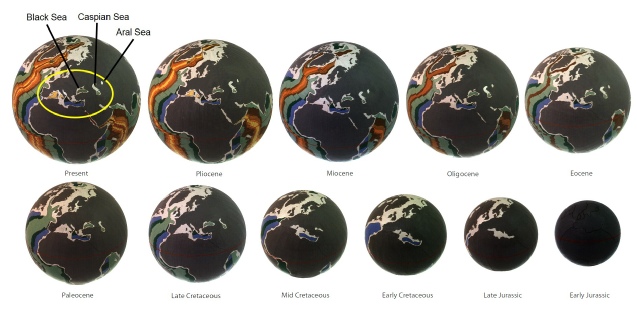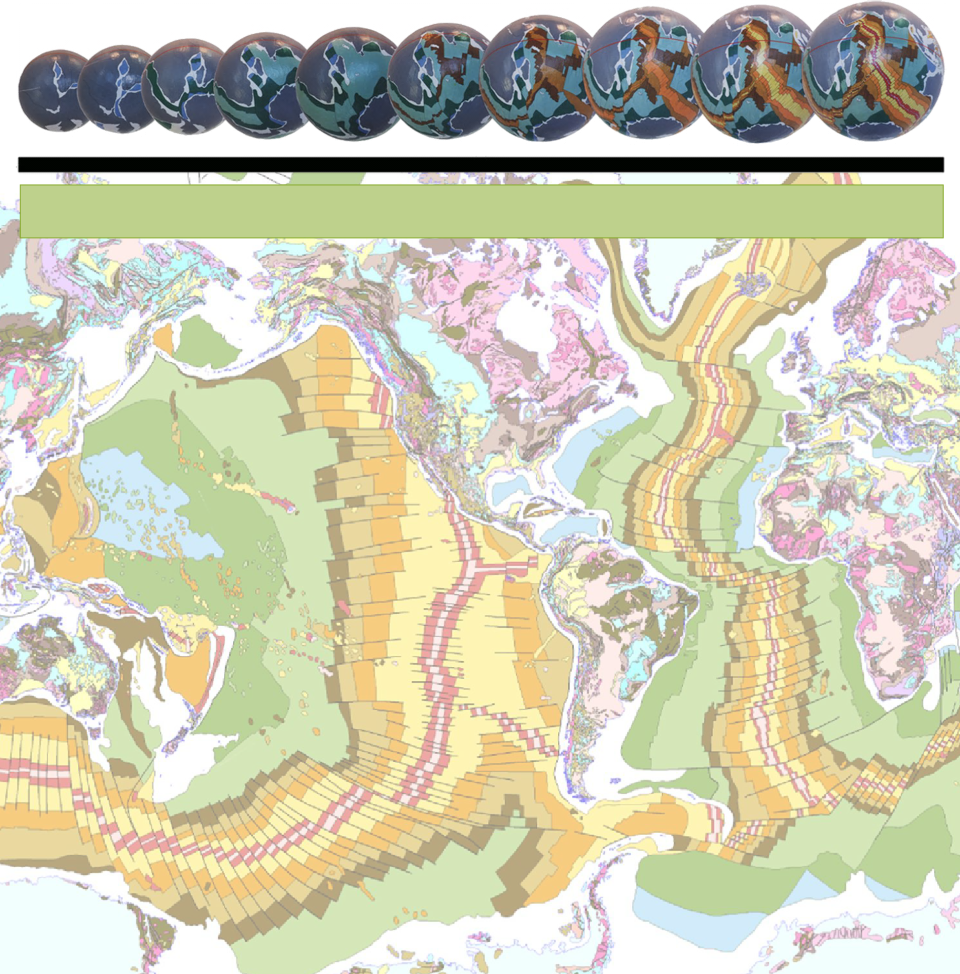MEDITERRANEAN SEA
The Mediterranean to Middle East region is a complex and contentious region on plate tectonic reconstructions. In order to reconstruct the supercontinents on a constant radius Earth, both Europe and Asia must be fragmented in order to close the Atlantic and Indian Oceans. On all conventional reconstructions the Mediterranean region then forms the western apex of a large triangular-shaped ancient Tethys Ocean. From there, this ocean is inferred to widen eastward towards an even larger ancient Panthalassa Ocean which separated the ancient supercontinents of Gondwana in the south and Laurasia in the north.

Mediterranean Sea Expansion Tectonic small Earth spreading history, extending from the present-day back to the early-Jurassic.
The development and evolution of the Mediterranean to Middle East region on an Expansion Tectonic Earth represents the remnants of a more extensive continental Tethys Sea—as distinct from a conventional Tethys Ocean. This Tethys Sea has had an extensive crustal and sedimentary basin history, extending back to the early Precambrian times.
On an Expansion Tectonic Earth the Mediterranean region initially developed during pre-Triassic times as a result of crustal extension between the ancient African and European continents. Crustal rupture within the ancient continental Tethys Sea then commenced during the Jurassic, which initiated opening of the modern Mediterranean Sea and crustal development within the Middle East region. The ancient Tethys Sea, in effect, represents the seabed of what is now the continental region of central Europe, the Middle East, and Asia.
Opening of the Caspian Sea followed during the early-Cretaceous Period. The Black Sea then followed during the mid-to late-Cretaceous and the Aral Sea during the Paleocene. These small seas all represent regions of continental crustal rupture and opening, which was initiated during complex clockwise crustal rotation occurring between the combined African-Arabian plate and central Europe.
Seafloor geological mapping shows that crustal extension within the Mediterranean to Middle East region was only active during Jurassic and early-Cretaceous times. From mid-Cretaceous to Miocene times complex crustal motions, including some localised compression between Africa and Europe, formed the Alpine Mountain belts. This event was followed by a continuation of continental crustal extension and renewed basin opening forming the young sedimentary basins presently located within much of central Europe.
This Alpine Mountain building event coincided with a northward extension of the North Atlantic Ocean spreading ridge which was marked by the opening of the Bay of Biscay, located between Spain and France, during the late-Cretaceous. Similarly, opening of the Persian Gulf and Red Sea also commenced during the Eocene and these are continuing to open to the present-day. Seafloor spreading was re-activated in the western Mediterranean region during the Miocene and was accompanied by continental rifting between West Africa and Spain.
On an Expansion Tectonic Earth separation of the Gondwana and Laurasia supercontinents by a large Tethys Ocean, and similarly a north-south closure of the Tethys Ocean during the Mesozoic and Cenozoic Eras, is not required. Instead, opening of the Mediterranean to Middle East region occurred as a result of clockwise rotation and crustal extension between Europe and the Middle East, relative to the adjoining African-Arabian continent. This continental crustal motion, extending from the Iberian Peninsula to the Tibetan Plateaux, also resulted in the rotation of Italy and fragmentation of the Alpine mountain belts during the mid-Cretaceous to present-day times.
The Expansion Tectonic small Earth reconstructions also present a straightforward development history for the Black Sea region, the mountain belts of the Balkans, Turkey, and the Caucasus, the development of the southern Russian platform north of the Black Sea and the development of the Aegean Sea during the late-Cenozoic.


